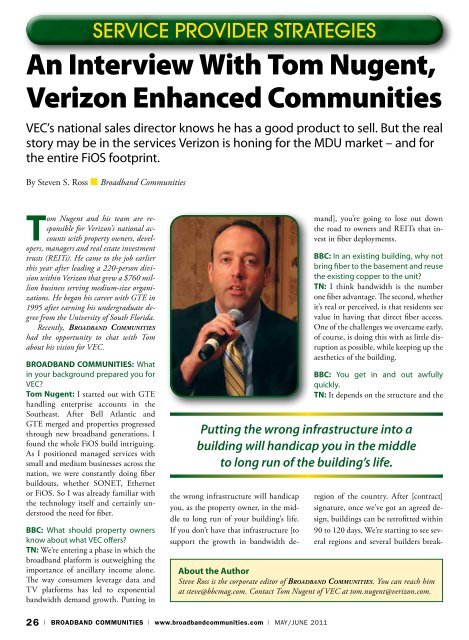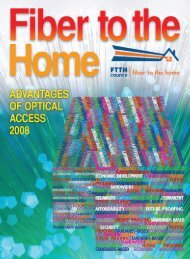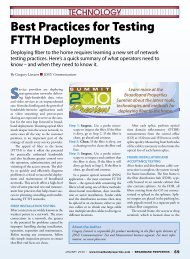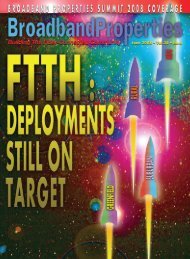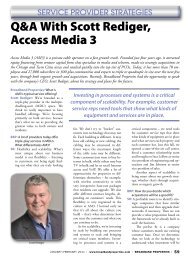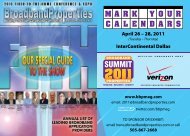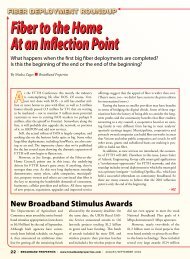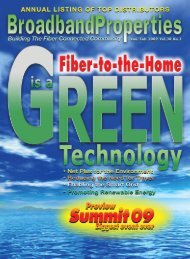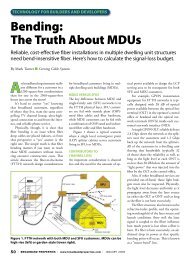An Interview With Tom Nugent, Verizon Enhanced Communities
An Interview With Tom Nugent, Verizon Enhanced Communities
An Interview With Tom Nugent, Verizon Enhanced Communities
Create successful ePaper yourself
Turn your PDF publications into a flip-book with our unique Google optimized e-Paper software.
SERVICE PROVIDER STRATEGIES<br />
<strong>An</strong> <strong>Interview</strong> <strong>With</strong> <strong>Tom</strong> <strong>Nugent</strong>,<br />
<strong>Verizon</strong> <strong>Enhanced</strong> <strong>Communities</strong><br />
VEC’s national sales director knows he has a good product to sell. But the real<br />
story may be in the services <strong>Verizon</strong> is honing for the MDU market – and for<br />
the entire FiOS footprint.<br />
By Steven S. Ross ■ Broadband <strong>Communities</strong><br />
<strong>Tom</strong> <strong>Nugent</strong> and his team are responsible<br />
for <strong>Verizon</strong>’s national accounts<br />
with property owners, developers,<br />
managers and real estate investment<br />
trusts (REITs). He came to the job earlier<br />
this year after leading a 220-person division<br />
within <strong>Verizon</strong> that grew a $760 million<br />
business serving medium-size organizations.<br />
He began his career with GTE in<br />
1995 after earning his undergraduate degree<br />
from the University of South Florida.<br />
Recently, Broadband <strong>Communities</strong><br />
had the opportunity to chat with <strong>Tom</strong><br />
about his vision for VEC.<br />
Broadband <strong>Communities</strong>: What<br />
in your background prepared you for<br />
VEC<br />
<strong>Tom</strong> <strong>Nugent</strong>: I started out with GTE<br />
handling enterprise accounts in the<br />
Southeast. After Bell Atlantic and<br />
GTE merged and properties progressed<br />
through new broadband generations, I<br />
found the whole FiOS build intriguing.<br />
As I positioned managed services with<br />
small and medium businesses across the<br />
nation, we were constantly doing fiber<br />
buildouts, whether SONET, Ethernet<br />
or FiOS. So I was already familiar with<br />
the technology itself and certainly understood<br />
the need for fiber.<br />
BBC: What should property owners<br />
know about what VEC offers<br />
TN: We’re entering a phase in which the<br />
broadband platform is outweighing the<br />
importance of ancillary income alone.<br />
The way consumers leverage data and<br />
TV platforms has led to exponential<br />
bandwidth demand growth. Putting in<br />
mand], you’re going to lose out down<br />
the road to owners and REITs that invest<br />
in fiber deployments.<br />
BBC: In an existing building, why not<br />
bring fiber to the basement and reuse<br />
the existing copper to the unit<br />
TN: I think bandwidth is the number<br />
one fiber advantage. The second, whether<br />
it’s real or perceived, is that residents see<br />
value in having that direct fiber access.<br />
One of the challenges we overcame early,<br />
of course, is doing this with as little disruption<br />
as possible, while keeping up the<br />
aesthetics of the building.<br />
BBC: You get in and out awfully<br />
quickly.<br />
TN: It depends on the structure and the<br />
Putting the wrong infrastructure into a<br />
building will handicap you in the middle<br />
to long run of the building’s life.<br />
the wrong infrastructure will handicap<br />
you, as the property owner, in the middle<br />
to long run of your building’s life.<br />
If you don’t have that infrastructure [to<br />
support the growth in bandwidth deregion<br />
of the country. After [contract]<br />
signature, once we’ve got an agreed design,<br />
buildings can be retrofitted within<br />
90 to 120 days. We’re starting to see several<br />
regions and several builders break-<br />
About the Author<br />
Steve Ross is the corporate editor of Broadband <strong>Communities</strong>. You can reach him<br />
at steve@bbcmag.com. Contact <strong>Tom</strong> <strong>Nugent</strong> of VEC at tom.nugent@verizon.com.<br />
26 | BROADBAND COMMUNITIES | www.broadbandcommunities.com | May/June 2011
SERVICE PROVIDER STRATEGIES<br />
ing ground again, and greenfield infrastructure<br />
goes up much more quickly<br />
because we embed the fiber into the wall<br />
structure.<br />
BBC: At what point do you get involved<br />
in a new building’s design<br />
TN: We ideally want to be involved up<br />
front as our partners are doing the design<br />
of the building, well before they<br />
break ground. However, we have been<br />
successful with FiOS builds regardless<br />
of the building construction phase. Our<br />
goal is to work cooperatively on design<br />
that meets the client’s needs.<br />
Concierge Services<br />
BBC: Can you talk a bit about Concierge<br />
and what it might offer down<br />
the road<br />
TN: Concierge is an amenities management<br />
platform that lays the foundation<br />
for communication among neighbors,<br />
communities and property managers. It<br />
has a range of functions, such as package<br />
tracking, resident alerts and mobile<br />
applications. A resident can ask for help<br />
with a maintenance ticket, view cameras<br />
on a property or order a pizza using a<br />
smartphone, a TV or a computer. We’ve<br />
even taken it out into the communities so<br />
there’s a unified wallet that a resident can<br />
leverage to buy locally and to buy globally.<br />
Most recently, we added Groupon,<br />
1-800-Flowers, OpenTable reservations<br />
and things of that nature that really set<br />
a property apart from others. The idea<br />
is to create that stickiness so that when<br />
residents’ leases are up, they think twice,<br />
three times, four times, and then they resign<br />
rather than look at a new property.<br />
We’re seeing a growing interest in<br />
more than just voice, data and video.<br />
<strong>With</strong> Concierge specifically, we’ve seen<br />
that owners and property managers take<br />
a keen interest in communicating with<br />
their residents in ways that stimulate<br />
feedback. It’s more than just the portal<br />
and more than just the Web access.<br />
People now are on the go and want to<br />
interact remotely, so mobile applications<br />
are hot.<br />
The next thing that’s coming is the<br />
whole concept of the Connected Home –<br />
everything from being able to control<br />
your lights and your security and manage<br />
your energy use not only to meet<br />
VEC’s new Connected Home services hit<br />
multiple hot buttons for residents – cost saving,<br />
carbon footprint reduction, security and,<br />
not least, the “cool” factor.<br />
your economic goals but also to reduce<br />
your carbon footprint. It has been huge,<br />
and it’s driven by the residents. We’ve<br />
got platforms in place that we’re launching<br />
with developer packages throughout<br />
2011 that will enable buildings to differentiate<br />
themselves.<br />
BBC: Is that integrated with Concierge,<br />
or is that a separate thing<br />
TN: It will be loosely linked. You can<br />
have one without the other.<br />
BBC: What does it cost owners<br />
TN: Our Concierge platform is free<br />
of charge for FiOS-enabled buildings.<br />
Owners can leverage Concierge as a communications<br />
channel with residents and<br />
a building-based social network to help<br />
make an apartment a longer-term home<br />
and help build a community. The Connected<br />
Home platform, which enables<br />
management of lights, camera monitoring,<br />
door locks, energy consumption<br />
and more, is a paid-for platform.<br />
BBC: Who pays for Connected Home –<br />
property owners or tenants<br />
TN: Connected Home is paid for by the<br />
residents. We are finalizing the developer<br />
offers and have pilots starting that<br />
include bulk options allowing builders<br />
to buy on behalf of their residents at discounted<br />
rates.<br />
BBC: A year ago, property owners<br />
were worried about these platforms’<br />
adding to their workloads. This year,<br />
those complaints seem muted. What<br />
improvements did you make<br />
TN: I wish I could say that <strong>Verizon</strong> alone<br />
was driving this. The reason Concierge<br />
and Connected Home are catching fire<br />
is simply that consumers are driving the<br />
need for these applications. What we’re<br />
seeing is that this is a differentiator to<br />
help property managers, owners and<br />
REITs attract and retain clients. There’s<br />
also a small opportunity, and I would<br />
stress small opportunity, to drive additional<br />
revenues.<br />
BBC: <strong>An</strong>y particular location or housing<br />
type causing the buzz<br />
TN: No. We see potential for Concierge<br />
and Connected Home across luxuries,<br />
high-rises, across geographies, across<br />
REITs, property owners and property<br />
managers all the way down to the residents.<br />
It hits multiple hot buttons. Can I<br />
save on energy Can I reduce my carbon<br />
footprint Am I consciously doing right<br />
by the world <strong>An</strong>other hot button is this<br />
whole concept of safety and security, the<br />
ability to manage and monitor via cameras,<br />
the ability to turn lights on and off<br />
automatically so that when I’m stepping<br />
outside at night, the lights can come<br />
on for me, or when I’m about to come<br />
home, I can turn on the lights before<br />
I get there. I can monitor the environment<br />
via cameras to make sure it’s safe.<br />
The final hot button is the “cool”<br />
factor. A lot of folks like the cool convenience<br />
of being able to control their<br />
appliances, their bills and their lights all<br />
via their mobile pads or phones, via the<br />
Web and via the TV.<br />
BBC: Down the road, app developers<br />
could create other applications<br />
for FiOS communities – telehealth,<br />
distance learning and so forth. Is that<br />
something VEC specifically, or <strong>Verizon</strong><br />
as a whole, is considering<br />
TN: Health & Wellness is a corporatewide<br />
initiative of which <strong>Verizon</strong> <strong>Enhanced</strong><br />
<strong>Communities</strong> is on the leading<br />
edge. We’ve partnered with Healthsense,<br />
and we’re in negotiations currently with<br />
several properties to embed wireless<br />
nurse calls and monitoring systems with<br />
FiOS as the underlying technology.<br />
May/June 2011 | www.broadbandcommunities.com | BROADBAND COMMUNITIES | 27
SERVICE PROVIDER STRATEGIES<br />
Folks are using it in different situations.<br />
One is in traditional senior care,<br />
and you also see this in naturally aging<br />
communities. Loved ones and caregivers<br />
are interested in remote management and<br />
remote monitoring so family members<br />
can live an independent lifestyle longer.<br />
Often Health & Wellness enhances<br />
our ability to pull through additional<br />
revenues while delivering high-end services<br />
to the senior community. Health &<br />
Wellness is how we’re changing the story<br />
and making it resonate with a growing<br />
population of baby boomers and seniors,<br />
while driving revenue back to <strong>Verizon</strong>.<br />
What Property Owners<br />
Need to Know<br />
BBC: When property owners start<br />
negotiating with VEC, what do they<br />
need to know ahead of time, and how<br />
do you tell them, “It’s not just triple<br />
play anymore”<br />
TN: Our business development managers<br />
are trained in all these services in each of<br />
the regions where we’ve deployed FiOS.<br />
But we’ve taken it one step further; we’ve<br />
adopted the concept of having sales engineers<br />
who are technically savvy when<br />
they talk about these applications and<br />
what they mean to a property – not only<br />
to the folks who make decisions about<br />
ancillary income and infrastructure but<br />
also to the folks in charge of IT and marketing.<br />
We try to take a more strategic or<br />
consultative approach to selling.<br />
BBC: But the triple play still drives revenue,<br />
doesn’t it<br />
TN: We do believe the triple play of<br />
voice, video and data is still a primary<br />
driver today. But we see the applications<br />
in Connected Home, in Concierge and<br />
in Health & Wellness as what’s going to<br />
take us over the top in years to come.<br />
Defining the Client<br />
BBC: Who are your clients Are they<br />
end-user customers, building owners<br />
and managers, or both<br />
TN: Both. We have a unique strategy<br />
in the B-to-B relationship. We want to<br />
strike as many of those mutually beneficially<br />
relationships as possible to get to<br />
the B-to-C relationship.<br />
BBC: Is there any particular contact<br />
point at VEC for people who have<br />
new apps or new ideas for you How<br />
did you match up with Groupon, for<br />
example<br />
TN: Mike Weston, director of marketing<br />
for VEC, leads our business development<br />
efforts. His team does strategic<br />
planning and product design specific to<br />
the multifamily market.<br />
The Fiber Advantage<br />
BBC: Why can all this be done only<br />
through fiber Many of these applications<br />
don’t need the high bandwidth.<br />
TN: Some of it has to do with bandwidth,<br />
and some of it has to do with crystal clarity<br />
and reliability. We believe that fiber<br />
accommodates exponential bandwidth<br />
growth for the years and decades to<br />
come. We see mobile devices connecting<br />
at an exponential rate, we see gaming increasing,<br />
we see video demand climbing,<br />
we see the additional applications that<br />
we haven’t even taken to market yet all<br />
driving bandwidth consumption. <strong>With</strong>out<br />
an infrastructure that’s going to grow<br />
with the building, [property owners] are<br />
going to be left in the age of the dinosaurs.<br />
We truly believe that, and we’ve<br />
seen that many of our large national,<br />
regional and individual owner partners<br />
agree. They are seeing the benefits of being<br />
able to attract and retain residents via<br />
technology as an amenity.<br />
BBC: So what about the old story line<br />
of ancillary income<br />
TN: We certainly address ancillary income<br />
via cooperative marketing agreements.<br />
We see the property as a partner<br />
in the business. However, ancillary income<br />
is not the lead value we bring to<br />
the table, nor do we lead with it. Clients<br />
want a superior product that differentiates<br />
their property. In addition, they<br />
want reliability – and FiOS is a highly<br />
reliable network.<br />
When you start talking about applications<br />
that people not only become<br />
accustomed to but also become dependent<br />
on, such as Connected Homes and<br />
Concierge and certainly critical Health<br />
& Wellness applications, you can’t have<br />
a network going down. So we’ve built a<br />
highly reliable fiber infrastructure.<br />
BBC: What do you think is responsible<br />
for the entrepreneurial quality<br />
of VEC Is it more entrepreneurial because<br />
it has a more focused mission<br />
or because of the technology<br />
TN: One of the things <strong>Verizon</strong> <strong>Enhanced</strong><br />
<strong>Communities</strong> has been afforded<br />
by <strong>Verizon</strong> is investment. The company<br />
has invested a great deal in FiOS, but<br />
it has also seen that it is incredibly important<br />
to target the very niche MDU<br />
market. That approach requires a little<br />
more finesse and a little more touch and<br />
a little more creativity than the mass<br />
rollout of FiOS. Eric Cevis [the <strong>Verizon</strong><br />
vice president responsible for VEC] has<br />
acted as a visionary. He has taken the investment<br />
that <strong>Verizon</strong> has made in VEC<br />
and consistently shown a return on that<br />
investment, not only for the corporation<br />
in the form of revenues, average revenue<br />
per user (ARPU) and expense-to-revenue<br />
metrics but also in consumers’ eyes.<br />
BBC: We see <strong>Verizon</strong> <strong>Enhanced</strong> <strong>Communities</strong><br />
as something of a laboratory<br />
for all of FiOS and for the whole<br />
broadband industry down the road.<br />
TN: Innovation is something that VEC,<br />
and <strong>Verizon</strong> as a whole, prides itself on.<br />
VEC has been afforded the opportunity<br />
to work with a special segment of the<br />
market. We have listened to the multifamily<br />
industry to deliver specific technologies<br />
and applications. I think you’re<br />
constantly going to see this where we are<br />
today and in what we’ll do tomorrow.<br />
BBC: What you’re really saying is that<br />
you’ll be adding to ARPU with more<br />
services.<br />
TN: I think that’s a fair statement. On<br />
the Concierge platform, more than<br />
180,000 living units (and growing) have<br />
Concierge services. <strong>An</strong>d what we see<br />
in those properties is solid growth in<br />
<strong>Verizon</strong> penetration rates. That’s good<br />
not only for the property that might be<br />
partnering with us to drive that penetration,<br />
but also, obviously, for <strong>Verizon</strong>.<br />
We’re seeing that across each one of our<br />
geographies, and we’re seeing it across<br />
each one of the different MDU styles,<br />
whether it’s a garden style, a mid-rise or<br />
a high-rise, luxury facility.<br />
When we talk about Connected<br />
Home, we have multiple properties in<br />
28 | BROADBAND COMMUNITIES | www.broadbandcommunities.com | May/June 2011
negotiations right now. What we’ve<br />
seen in both owner-occupied and rental<br />
properties is that they are really trying<br />
to figure out how they leverage this connected<br />
home to help differentiate their<br />
properties via these “green” packages.<br />
BBC: Do groups come to you knowing<br />
that you have the platform<br />
TN: We are spreading the word about<br />
Concierge, Connected Home and<br />
Health & Wellness through many channels,<br />
including the recent Broadband<br />
Properties conference. Each one of these<br />
application services goes through rigorous<br />
trials. We try to put on the glasses of<br />
the consumer – the MDU user, the tenant,<br />
the senior-living resident, those who<br />
would be interested in Connected Home<br />
or health applications. If it can pass the<br />
consumer test and we see a demand for<br />
it, we make sure we have a platform that<br />
will deliver. So I see an upward pressure<br />
in communities, with residents saying,<br />
“Hey, we’re very interested in this health<br />
and wellness application or energy application.”<br />
Candidly, that’s really what<br />
we think turned the tide, as the REITs<br />
and the building owners are hearing the<br />
same thing. Their customers want this<br />
service, and they need help to deliver it.<br />
BBC: <strong>An</strong>d it’s not costing them out of<br />
pocket, really.<br />
TN: It does not have to cost the owner.<br />
In fact, the consumer is willing to pay<br />
because it provides value, whether it’s an<br />
economic return or whether it hits the<br />
green, the safety or the cool benefits.<br />
Wellness is the same way. When you<br />
start talking about the security and wellbeing<br />
of providing care remotely, that’s<br />
a huge value, and we’re trying to offer<br />
this at a very low cost to the end user.<br />
Some of the building owners have said<br />
they want to bake this in, so for those<br />
owners we establish bulk offers with discounted<br />
rates.<br />
BBC: You gave up the requirement<br />
for a two-year contract commitment<br />
from FiOS consumers. Are you going<br />
to continue that policy<br />
TN: In some scenarios, we don’t believe<br />
we need a contract to keep that retention<br />
rate up – and consumers like [not hav-<br />
May/June 2011 | www.broadbandcommunities.com | BROADBAND COMMUNITIES | 29
SERVICE PROVIDER STRATEGIES<br />
ing two-year commitments]. We’re also<br />
looking at such policies as direct deposit<br />
to insure that we can get past some of the<br />
credit challenges for customers who want<br />
to use FiOS services.<br />
Mobile Networks<br />
BBC: In the next few years, <strong>Verizon</strong><br />
and AT&T are putting their money<br />
into mobile networks, bringing fiber<br />
to cell towers, erecting more cell sites<br />
and so forth. We expect more mobile<br />
connections will be made through<br />
users’ home networks, via either Wi-<br />
Fi or femtocells. Are you thinking the<br />
same way and planning for that<br />
TN: Absolutely. Mobility touches every<br />
aspect of our business, whether on the<br />
traditional telecom side or the core <strong>Verizon</strong><br />
Wireless side. <strong>Verizon</strong> has an aggressive<br />
fiber-to-the-cell-site initiative.<br />
That is very public, and we will continue<br />
to invest in <strong>Verizon</strong> Wireless platforms.<br />
On the FiOS side, we deploy Wi-Fi<br />
routers with each data install to enable<br />
a connected lifestyle.<br />
BBC: Are you seeing property owners<br />
interested in turning function rooms<br />
into work centers<br />
TN: We have seen a groundswell of<br />
work-at-home customers. We have seen<br />
some buildings that have set up work<br />
stations in common areas, but I think<br />
more predominantly we’ve seen it at the<br />
end-user level, [customers] turning parts<br />
of their residences into home offices.<br />
BBC: When VEC first started bringing<br />
fiber to MDUs, owners had a lot of<br />
reservations about it. Are you still encountering<br />
those reservations, or has<br />
everyone more or less seen the light<br />
TN: One of the franchise areas that we<br />
recently opened is Washington, D.C.<br />
I was [there] yesterday talking to our<br />
business development managers and<br />
sales engineers who are actually going<br />
out into the FiOS-enabled wire centers.<br />
The positive response by the communities<br />
has been overwhelming. There is<br />
pent-up demand there, and people are<br />
very excited to experience FiOS and<br />
bring that to their residents.<br />
It was amazing that they would almost<br />
recite the value proposition that<br />
we’ve been preaching for several years<br />
now, saying, “Please come in and offer<br />
us a choice. We need fiber for reliability,<br />
for speed, for crystal-clear pictures.”<br />
<strong>With</strong> that said, we certainly have areas<br />
where properties are in lucrative legacy<br />
contracts with cable providers and<br />
candidly, that’s not the business we’re<br />
in. So when those contracts expire, and<br />
[owners] want to move over to the value<br />
of <strong>Verizon</strong> for their tenants, we expect to<br />
capture some of those properties.<br />
Our business motto is that we’re<br />
here to help owners attract and retain<br />
residents. We have business professionals<br />
in each of the FiOS regions that are<br />
happy to talk to owners and walk them<br />
through what they as business owners<br />
can derive and what their residents can<br />
derive from enabling a property with<br />
FiOS. <strong>An</strong>d we can also bring in our engineering<br />
teams to address any concerns<br />
out there with regard to greenfield or<br />
retrofit properties. v<br />
Motorola’s Passive<br />
Optical LAN Solution…<br />
Fiber to the ________.<br />
A. Desk<br />
B. Dorm<br />
C. Guestroom<br />
D. Hospital Bed<br />
E. Classroom<br />
F. All of the Above<br />
Motorola’s Passive Optical LAN (POL) Solution is a highly reliable and<br />
economically disruptive LAN solution that will revolutionize how voice,<br />
video and data are distributed throughout the enterprise. POL replaces<br />
existing LAN connections with a single high capacity fiber optical cable<br />
designed to connect the end user directly to the data center. Derived from<br />
carrier grade passive optical networking (PON) technology, POL allows<br />
end users to realize substantial CAPEX and OPEX savings while taking<br />
significant steps towards becoming a more green enterprise.<br />
For more information, call us at 888.293.5856 or visit amt.com.<br />
Motorola AXS 1800<br />
Multiple Solutions. One Source.<br />
Advanced Media Technologies ® | 3150 SW 15th Street | Deerfield Beach, FL 33442<br />
954.427.5711 | www.amt.com | sales@amt.com<br />
MOTOROLA and the Stylized M Logo are registered in the US Patent and Trademark Office. © Motorola, Inc. 2011<br />
30 | BROADBAND COMMUNITIES | www.broadbandcommunities.com | May/June 2011


